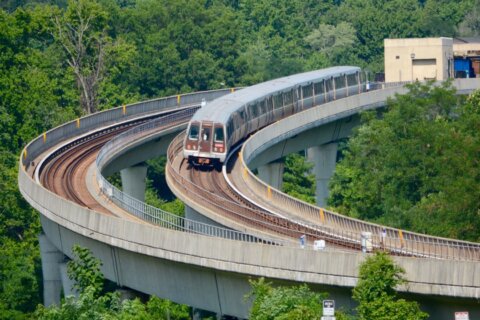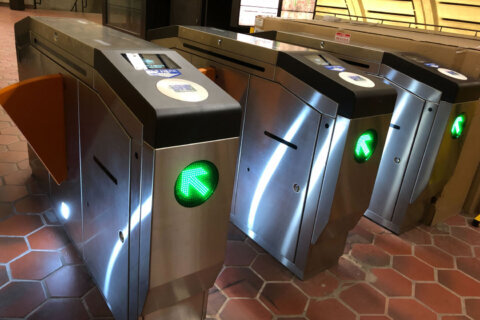Metro is proposing closing two hours early most weeknights, running trains less frequently during regular rush hours and requiring riders to start paying bus fares again as part of a plan to close a more than $200 million budget gap caused by the coronavirus pandemic.
In budget documents set to be discussed Thursday by the Metro Board, the transit system said ridership has failed to bounce back from pandemic-related changes as initially expected, with most schools in the area providing virtual classes and many employees continuing to telework.
“These factors have heavily suppressed revenue and ridership,” the budget documents state.
Overall, ridership across the system is still down about 88% compared to pre-pandemic levels. That’s even after Metro last month ramped up rail service back to pre-pandemic levels.
In addition, more than $876 million in emergency funding provided by Congress in the CARES Act to replace lost revenue and pay worker salaries is expected to be depleted entirely by January, an event the budget documents characterize as a “fiscal cliff.”
So far, Metro has already spent $537 million of the federal funding, and there’s no guarantee Congress will approve additional funding.
- Sign up for WTOP alerts
- Latest coronavirus test results in DC, Maryland and Virginia
- Local council of governments grapples with cross-jurisdiction contact tracing
- NIH: Halted vaccine study shows ‘no compromises’ on safety
- Trump admits to concealing the true threat of coronavirus in new Woodward book
- Maryland added to New York travel advisory list
- Coronavirus resources: Get and give help in DC, Maryland and Virginia
Looking for more information? D.C., Maryland and Virginia are each releasing more data every day. Visit their official sites here: Virginia | Maryland | D.C.
Proposed Metrorail changes
On the rails, Metro is proposing cutting hours, closing the system at 9 p.m. Sunday through Thursdays.
The system would stay open until 11 p.m. only on Fridays and Saturdays. Currently, the system is open until 11 p.m. every night.
The cost-cutting plan also calls for longer waits for trains, proposing running trains every 12 minutes on each line on weekdays. Currently, trains are running every eight minutes.
In addition, Metro would implement what are known as turnbacks on the Red and Yellow lines, where trains don’t run the full-length of the line but turn around earlier to serve core areas.
Under Metro’s plan, all trips on the Yellow Line would begin and end at Mt. Vernon Square. On the Red Line, every other trip would run only from Grosvenor to Silver Spring.
Metro said it also planned to push back officially opening Phase Two of the Silver Line — which includes a stop at Dulles International Airport — to July.
Proposed Metrobus changes
For bus riders, Metro’s plan would stick with the reduced level of service it rolled out last month — under which there are no trips starting after midnight and more than 30 routes have been canceled entirely. Metro does not plan to add back any bus service.
However, Metro wants to start charging riders the $2 fare again starting in January.
All Metrobus rides have been free since March, when Metro moved to rear-door boarding to reduce contact between drivers and passengers. Metro said it expects to net $5 million from bus fares. The documents say drivers would be protected by panels near the driver’s seat.
“Returning to front-door boarding would also allow more riders to board with increased seat availability, and consequently, increase social distancing space,” Metro said in the documents.
The changes being proposed are set to be discussed by the Metro Board on Thursday, with a public hearing set for sometime in October.
If approved by the board, the changes would take effect in January.
All told, Metro documents say those changes to bus and rail service would net $169 million in savings.
Metro planning for ‘widespread resurgence’ of virus
The total budget gap Metro planners need to plug is about $212 million.
Of that, Metro General Manager Paul Wiedefeld has proposed $43 million in savings through contracting efficiencies, reducing the number of managers to one per station, eliminating “runners” who assist station manager, and furloughing and laying off nonunion staff.
The system aims for another $30 million in savings by putting off capital programs that it says won’t have an impact on safety, including the purchase of some IT equipment and the installation of some digital screens at stations.
The planning documents lay out a grim portrait of the system’s financial health well into the future.
For one, Metro officials don’t expect ridership to return anytime soon. Even by the end of the fiscal year — the end of June 30, 2021 — Metro predicts system ridership will be only 20% of what it was pre-pandemic.
Metro’s estimates of ridership and revenue predict a “widespread resurgence” of the virus this fall and winter, and that a vaccine remains unavailable widely through at least the summer.
In addition, planners — who had initially predicted workplaces would slowly reopen by the end of the year — now predict a slower pace of business reopening, stretching into next summer.
Starting this fall, Metro plans to roll out a public health educational campaign using focus-group tested messages, seeking to reassure riders of the safety of the Metro system.
The document say officials expect the campaign “to move (the) needle” for people who have to travel or want to travel, “but most do not.”







